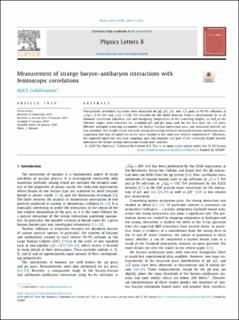Measurement of strange baryon–antibaryon interactions with femtoscopic correlations
Acharya, Shreyasi; Adamová, Dagmar; Adhya, Souvik Priyam; Adler, Alexander; Adolfsson, Jonatan; Aggarwal, Madan M.; Aglieri Rinella, Gianluca; Agnello, Michelangelo; Agrawal, Nikita; Ahammed, Zubayer; Alme, Johan; Altenkaemper, Lucas; Djuvsland, Øystein; Ersdal, Magnus Rentsch; Fionda, Fiorella Maria Celeste; Grøttvik, Ola Slettevoll; Lofnes, Ingrid Mckibben; Nystrand, Joakim; Rehman, Attiq ur; Røhrich, Dieter; Tambave, Ganesh Jagannath; Ullaland, Kjetil; Wagner, Boris; Yang, Shiming; Yuan, Shiming; Zhou, Zhuo; Arsene, Ionut Cristian; Bätzing, Paul Christoph; Dordic, Olja; Lardeux, Antoine Xavier; Lindal, Svein; Mahmood, Sohail Musa; Malik, Qasim Waheed; Richter, Matthias; Røed, Ketil; Skaali, Toralf Bernhard; Tveter, Trine Spedstad; Wikne, Jon Christopher; Zhao, Chengxin; Helstrup, Håvard; Hetland, Kristin Fanebust; Kileng, Bjarte; Nesbø, Simon Voigt; Storetvedt, Maksim Melnik; Langøy, Rune; Lien, Jørgen André; Ahmad, Shafiq F.; Ahn, Sang Un; Aiola, Salvatore; Akindinov, Alexander; ALICE, Collaboration
Journal article, Peer reviewed
Published version

Åpne
Permanent lenke
https://hdl.handle.net/11250/2757440Utgivelsesdato
2020Metadata
Vis full innførselSamlinger
Sammendrag
Two-particle correlation functions were measured for pp, p, p, and pairs in Pb–Pb collisions at √sNN = 2.76 TeV and √sNN = 5.02 TeV recorded by the ALICE detector. From a simultaneous fit to all obtained correlation functions, real and imaginary components of the scattering lengths, as well as the effective ranges, were extracted for combined p and p pairs and, for the first time, for pairs. Effective averaged scattering parameters for heavier baryon–antibaryon pairs, not measured directly, are also provided. The results reveal similarly strong interaction between measured baryon–antibaryon pairs, suggesting that they all annihilate in the same manner at the same pair relative momentum k∗. Moreover, the reported significant non-zero imaginary part and negative real part of the scattering length provide motivation for future baryon–antibaryon bound state searches.
